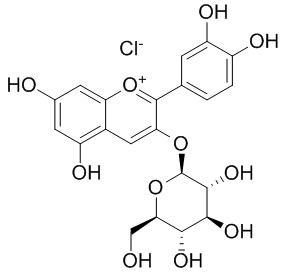Cyanidin-3-O-glucoside chloride
Cyanidin-3- O -glucoside exhibits strong antioxidant activities, it has protective effects from blackberry extract against peroxynitrite-induced endothelial dysfunction and vascular failure. Cyanidin-3-O-glucoside chloride decreased mutant p21 expression, and increased the ratio of Bax/Bcl-2 and the activation of caspase-3 to induce apoptosis. It has the function of raising blood sugar
concentration, maintaining the balance of Lipid metabolism and reducing obesity.
Inquire / Order:
manager@chemfaces.com
Technical Inquiries:
service@chemfaces.com
Tel:
+86-27-84237783
Fax:
+86-27-84254680
Address:
1 Building, No. 83, CheCheng Rd., Wuhan Economic and Technological Development Zone, Wuhan, Hubei 430056, PRC
Providing storage is as stated on the product vial and the vial is kept tightly sealed, the product can be stored for up to
24 months(2-8C).
Wherever possible, you should prepare and use solutions on the same day. However, if you need to make up stock solutions in advance, we recommend that you store the solution as aliquots in tightly sealed vials at -20C. Generally, these will be useable for up to two weeks. Before use, and prior to opening the vial we recommend that you allow your product to equilibrate to room temperature for at least 1 hour.
Need more advice on solubility, usage and handling? Please email to: service@chemfaces.com
The packaging of the product may have turned upside down during transportation, resulting in the natural compounds adhering to the neck or cap of the vial. take the vial out of its packaging and gently shake to let the compounds fall to the bottom of the vial. for liquid products, centrifuge at 200-500 RPM to gather the liquid at the bottom of the vial. try to avoid loss or contamination during handling.
J Chromatogr B Analyt Technol Biomed Life Sci.2018, 1080:27-36
Front Pharmacol.2017, 8:673
Evidence-based Compl.&Alternative Med.2023, 5417813
J Agric Food Chem.2024, 72(40):22237-22249.
Chem Res Toxicol. 2022, acs.chemrestox.2c00049.
J Funct Foods2019, 54:449-456
Journal of Applied Biology & Biotechnology2023,11(4):148-158
Comparative Clinical Pathology 2021, 30:961-971.
Nutrients.2020, 12(12):3607.
Evid Based Complement Alternat Med.2022, 2022:3483511
Related and Featured Products
Life Sci. 2003 Jul 18;73(9):1097-114.
Protective effects of cyanidin-3-O-glucoside from blackberry extract against peroxynitrite-induced endothelial dysfunction and vascular failure.[Pubmed:
12818719]
Anthocyanins are a group of naturally occurring phenolic compounds as colorants in several plants, flowers and fruits. These pigments have a great importance as quality indicators, as chemotaxonomic markers and antioxidants.
METHODS AND RESULTS:
The content of blackberry (Rubus species) juice was investigated by HPLC/ESI/MS using narrow bore HPLC columns. Using this method we demonstrated that cyanidin-3-O-glucoside represents about 80% of the total anthocyanin contents in blackberry extract. Here we investigated antioxidant activity of the blackberry juice and cyanidin-3-O-glucoside on the endothelial dysfunction in cells and in vascular rings exposed to peroxynitrite. In human umbilical vein endothelial cells (HUVEC) in vitro, peroxynitrite caused a significant suppression of mitochondrial respiration (38 +/- 2.1% of control cells), as measured by the mitochondrial-dependent conversion of the dye MTT to formazan. Peroxynitrite caused DNA strand breakage (63 +/- 1.9% single strand vs 3 +/- 0.9% single strand in control cells), as measured by the alkaline unwinding assay, and caused an activation of PARS, as measured by the incorporation of radiolabeled NAD(+) to nuclear proteins. Blackberry juice (different dilutions that contained 80 ppm;40 ppm;14.5 ppm of cyanidin-3-O-glucoside) and cyanidin-3-O-glucoside (as chloride) (0.085 microM; 0.028 microM; 0.0085 microM) reduced the peroxynitrite-induced suppression of mitochondrial respiration, DNA damage and PARS activation in HUVECs. Vascular rings exposed to peroxynitrite exhibited reduced endothelium-dependent relaxant responses in response to acetylcholine as well as a vascular contractility dysfunction in response to norepinephrine. The development of this peroxynitrite-induced vascular dysfunction was ameliorated by the blackberry juice (different dilutions that contained 80 ppm;40 ppm;14.5 ppm of cyanidin-3-O-glucoside) and cyanidin-3-O-glucoside (as Cyanidin-3-O-glucoside chloride) (0.085 microM;0.028 microM;0.0085 microM).
CONCLUSIONS:
In conclusion our findings clearly demonstrate that blackberry juice containing cyanidin-3-O-glucoside is a scavenger of peroxynitrite and that exert a protective effect against endothelial dysfunction and vascular failure induced by peroxynitrite.
Int J Mol Sci. 2016 Jul; 17(7): 993.
Cytotoxicity and Apoptotic Effects of Polyphenols from Sugar Beet Molasses on Colon Carcinoma Cells in Vitro[Pubmed:
27347927]
Three polyphenols were isolated and purified from sugar beet molasses by ultrasonic-aid extraction and various chromatographic techniques, and their structures were elucidated by spectral analysis. Cytotoxicity and the molecular mechanism were measured by methyl thiazolyl tetrazolium (MTT) assay, flow cytometry, caspase-3 activity assay and Western blot assay. The results showed that gallic acid, Cyanidin-3-O-glucoside chloride and epicatechin have cytotoxicity to the human colon, hepatocellular and breast cancer cells. Cyanidin-3-O-glucoside chloride showed its cytotoxicity against various tumor cell lines, particularly against colon cancer Caco-2 cells with half maximal inhibitory concentration (IC50) value of 23.21 ± 0.14 μg/mL in vitro. Cyanidin-3-O-glucoside chloride may be a potential candidate for the treatment of colon cancer. In the mechanism study, Cyanidin-3-O-glucoside chloride increased the ratio of cell cycle at G0/G1 phase and reduced cyclin D1 expression on Caco-2 cells. Cyanidin-3-O-glucoside chloride decreased mutant p21 expression, and increased the ratio of Bax/Bcl-2 and the activation of caspase-3 to induce apoptosis.
BMC Complement Altern Med. 2015; 15: 313.
Antioxidant and in vitro anticancer activities of phenolics isolated from sugar beet molasses[Pubmed:
26347338 ]
In the present study, the phenolic compounds were prepared using ultrasonic-aid extraction from sugar beet molasses (SBM).
METHODS AND RESULTS:
Gallic acid (GA), Cyanidin-3-O-glucoside chloride (CGC) and epicatechin (EP) were produced after column chromatography from the extraction, and further detected using NMR, QTOF-MS and ESI-MS/MS.
The three compounds exhibited strong antioxidant activities including DPPH radical scavenging activities, ABTS radical scavenging activities and ORAC values. GA showed the strongest antioxidant activity. Antitumor activities significantly increased in a dose-dependent manner. In particular, the CGC had growth inhibitory activities of 94.86, 87.27 and 67.13% against the human colon (CACO-2), hepatocellular (HepG2) and breast (MCF-7) carcinoma cell lines, respectively, at the highest concentration of 400 μg/mL of the extracts. These results suggest that the three compounds are key chemical compositions valuable for preparing functional foods in the food industry.
CONCLUSIONS:
The results suggested that SBM is a natural source of antioxidant and antitumor agents for preparing functional foods.



